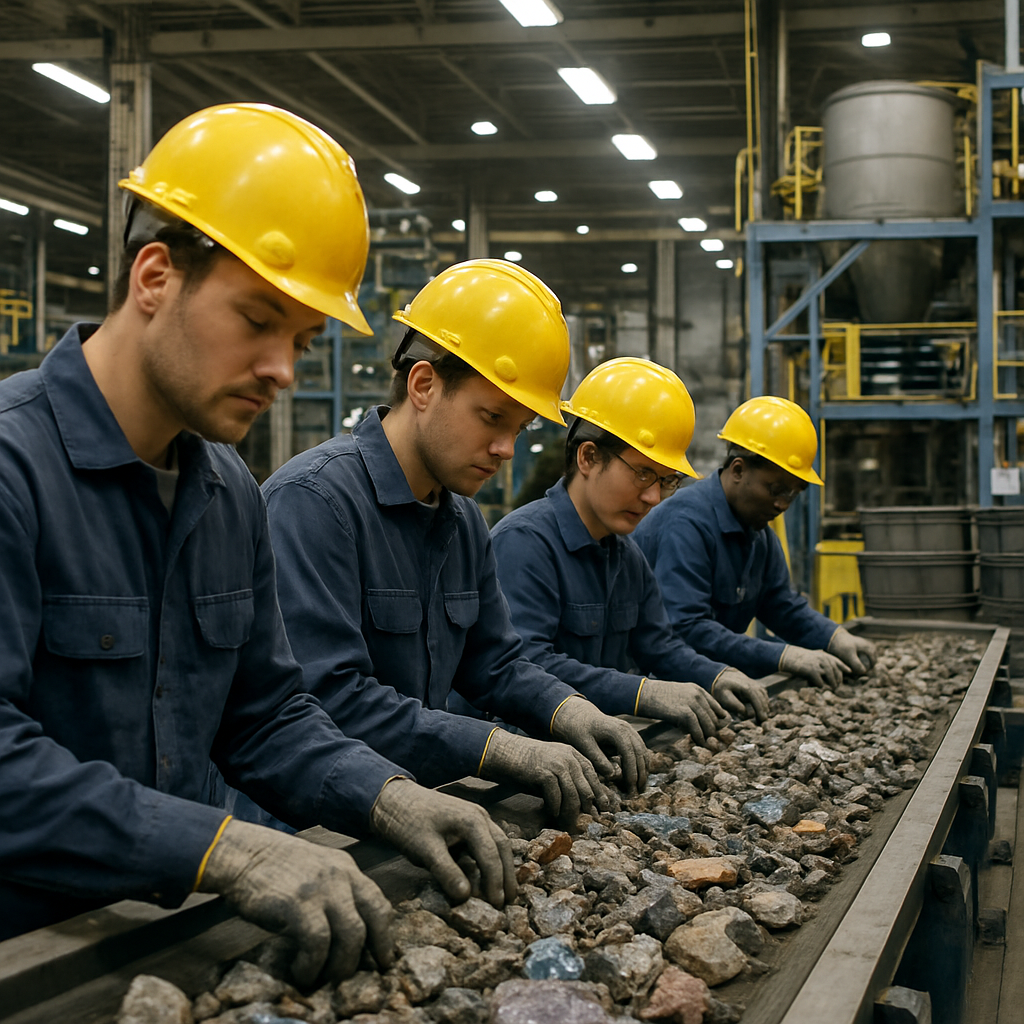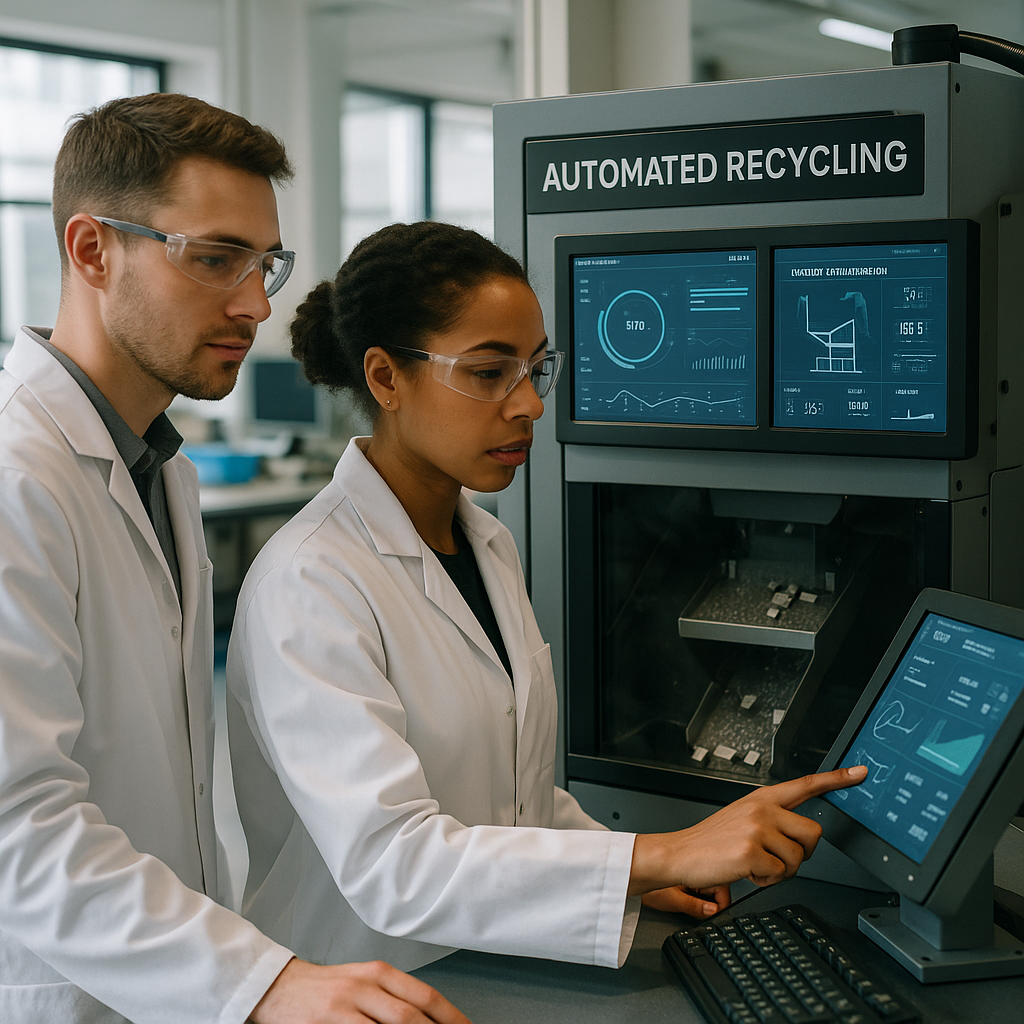5901 Botham Jean Blvd, Dallas, TX 75215
Magnet-to-Magnet Recycling: Costs, Innovations & Sustainability
September 2, 2025The magnetic materials recycling market has been exceptionally volatile over the past decade. In 2011, neodymium prices soared to $450 per kilogram before dropping to less than half that value just a year later. This extreme fluctuation illustrates the unpredictable nature of rare earth magnet recycling economics.
By 2025, distinct pricing patterns are emerging across various magnet types. Alnico magnets are currently valued at approximately $0.75 per pound in the scrap market, providing a steady but modest contribution to recycling revenues. In contrast, rare earth magnets containing neodymium command much higher prices due to their vital applications in green technology and electronics.
The overall magnet materials market has shown a strong growth trajectory, expanding from $7 billion in 2010 to a projected $15 billion by 2020. This rapid growth emphasizes the increasing importance of developing efficient recycling technologies and stable supply chains for these valuable materials. With rare earth magnets remaining a leading high-performance magnetic technology for the foreseeable future, the recycling market is set for continued expansion despite price uncertainties.
How Does the Rare Earth Supply Chain Impact Recycling Prices?

China dominates the global rare earth supply chain, controlling 97% of rare earth elements used in magnets. This near-monopoly creates significant pricing power that directly impacts recycling economics worldwide. The concentration of supply affects recycling prices through several key mechanisms.
China’s strategic approach to rare earth pricing includes occasional export restrictions that cause market volatility. In 2010, Beijing abruptly reduced export quotas by 37%, leading to rare earth import prices rising from $9,461 per metric ton to nearly $67,000 per metric ton by 2011. These dramatic price fluctuations force recycling operations to navigate unpredictable economics, often complicating long-term planning.
When China restricts exports, recycling becomes more economically viable as the price gap between virgin and recycled materials narrows. However, the recycling industry struggles to establish stable operations when China can quickly reverse course by flooding the market with low-cost materials. This pricing strategy allows China to maintain market dominance while discouraging competition from alternative sources.
The rare earth oxide production landscape further complicates recycling economics. Production was projected to grow from 125,000 tons in 2010 to 200,000 tons by 2015, creating potential oversupply that could depress prices. China often operates its rare earth supply chain at a loss to keep prices low. For instance, the cost of neodymium-praseodymium dropped by 20% between January and July 2024, making it challenging for recycling operations to compete with virgin materials.
The downstream manufacturing landscape presents additional challenges for recyclers. With fewer than 12 rare earth permanent magnet producers operating outside China, recycling operations struggle to find reliable buyers in regional markets. This limited buyer pool creates pricing pressure for recycled materials, as recyclers must compete for relationships with the few non-Chinese manufacturers.
Several factors suggest potential changes in this pricing dynamic:
- Supply chain diversification efforts by Western nations may create more stable pricing for recycled materials.
- Growing Chinese domestic consumption could transform China into a net importer by mid-decade.
- Environmental regulations in China are reducing its registered production capacity.
- New processing facilities in Texas, Malaysia, and Estonia aim to reduce dependence on Chinese processing.
The economics of recycling rare earths remain challenging as long as China maintains its grip on the supply chain. Until supply diversification efforts mature, recycling prices will continue to fluctuate based on China’s strategic decisions rather than traditional supply-demand economics. This unpredictability represents a significant barrier to establishing large-scale rare earth recycling operations in Western markets.
What are the Current Recycling Practices for Different Magnet Types?

The recycling approaches for rare earth permanent magnets differ significantly between the two main types: Neodymium-Iron-Boron (Nd-Fe-B) and Samarium-Cobalt (Sm-Co) magnets. Each type poses unique challenges due to differences in composition, value, and market dynamics.
For Nd-Fe-B magnets, which dominate the rare earth magnet market, several recycling methods are available. Some manufacturing scrap is remelted into new alloy, although this process can reduce the magnetic properties due to oxygen introduction, forming non-ferromagnetic rare earth oxides. These oxides accumulate during recycling, limiting the amount of recycled material usable in new magnets.
Conversely, Sm-Co magnets follow a distinct recycling process. Despite their significance, they contribute to just about 2% of total end-of-life magnet waste. Sm-Co recycling often focuses on recovering valuable cobalt rather than samarium, owing to cobalt’s higher market value.
Both magnet types share recycling challenges. Their brittle nature complicates handling and processing, and assembly with epoxy adhesives hinders separation. Moreover, rare earth powders can be highly reactive, raising safety concerns during processing. The varying compositions of scrap magnets present additional hurdles in establishing consistent recycling processes.
Manufacturing Waste: An Overlooked Opportunity
Recycling manufacturing waste is a significant but underutilized opportunity. In Nd-Fe-B magnet production, 20-30% of material becomes scrap, while Sm-Co production generates 15-30% waste as sludge and scrap. This manufacturing waste is ideal for recycling due to its known composition, lack of adhesive contamination, and concentration at production sites.
Several technologies address these recycling challenges. Direct methods, such as hydrogen decrepitation (HD) and hydrogenation-disproportionation-desorption-recombination (HDDR), aim to preserve the original composition while minimizing energy use. Hydrometallurgical processes use acids to dissolve magnets and recover valuable elements, whereas pyrometallurgical methods recover rare earths as alloys or compounds through high temperatures.
Recently, magnet-to-magnet recycling approaches have emerged, promoting a circular economy for rare earth magnets. This short-loop recycling involves cleaning used magnets, adding fresh rare earth elements as necessary, then crushing, homogenizing, and reforming them into new magnets through sintering and annealing. Life cycle assessments indicate that this process has at least a 50% lower environmental impact than virgin magnet production.
The H2020 SUSMAGPRO project has validated hydrogen processing of magnetic scrap (HPMS) at a pilot scale of 100 tons per year. This method offers an energy-efficient and environmentally friendly alternative to conventional recycling practices, producing high-quality powders for manufacturing high-performance magnets.
Electrochemical recycling has shown potential, particularly for Nd-Fe-B magnets. This method uses electrolysis to recover rare earth elements with high purity and minimal environmental impact. Recent advancements focus on efficiency improvements through various electrolytes, including molten salts, high-temperature solutions, and ionic liquids.
Despite these advances, less than 1% of rare earth elements are recycled globally. The primary barriers include economic obstacles, the technical complexity of recycling processes, and inconsistent material quality. Overcoming these challenges through ongoing innovation and supportive policies will be vital for establishing a sustainable circular economy for rare earth magnets.
What New Technologies are Emerging for Magnet Recycling?

Hydrogen-assisted recycling is leading innovations in magnetic material recovery. This breakthrough uses hydrogen to transform magnetic materials into reusable powder form while demagnetizing them. The process involves placing pre-processed magnet scrap into a hydrogen vessel, where the gas reacts with the magnets to form an alloy powder. This method avoids the environmental drawbacks of traditional techniques while preserving material integrity.
Once processed, the resulting powder can be directly remade into new magnets or further refined chemically. UK-based company HyProMag exemplifies this strategy with plans to open a chemical processing plant with the capacity to recycle at least 100 tonnes of magnets annually. Experts describe the process as “beautifully simple, elegant, and sustainable.”
A key advancement in this field is the development of Ni/Cu coating-free Nd-Fe-B magnets designed for easier recycling. Traditional neodymium magnets typically require nickel-copper-nickel coatings to prevent oxidation, complicating the recycling process. The new coating-free approach creates magnets with Ni-free surfaces containing only 1-2% oxygen content and Dysprosium (Dy) content ranging from 5-8%. This innovation greatly simplifies material recovery while maintaining performance.
Electronic Waste as a Valuable Resource
Hard disk drives are a rich source of rare earth magnets. Recent partnerships between rare earth processors and electronics recovery firms underscore the increased interest in this resource. For instance, a joint venture between HyProMag USA and electronics recycler Intelligent Lifecycle Solutions aims to secure a stable supply of neodymium iron boron (NdFeB) magnets from end-of-life hard drives.
In this arrangement, magnets are extracted from discarded electronics using automated technology and sent to advanced recycling facilities. The Dallas-Fort Worth facility, in development, is expected to process 750 metric tons of NdFeB magnets annually within five years of operation. This approach significantly reduces embedded carbon compared to traditional chemical recycling methods—by more than 88% according to company estimates.
The economic potential is substantial. With up to 70 rare earth motors in a modern vehicle and rare earth components in numerous electronic devices, recovering these materials generates new revenue streams for recyclers while addressing critical supply chain vulnerabilities.
Green Chemistry Approaches
Traditional solvent-based recycling often relies on harsh chemicals that pose environmental risks. Emerging green solvent technologies are offering more eco-friendly alternatives. Researchers are exploring biodegradable organic acids and ionic liquids as solvents for extracting rare earth elements.
Ionic liquids—salts in a liquid state—show particular promise for extracting rare earth elements without generating hazardous waste. These solvents facilitate separations at lower temperatures than conventional methods, reducing energy use in recycling. UK startup IonicTech has developed liquid-liquid extraction technology using liquid salts and ligands to chemically separate rare earth elements from crushed magnets.
Beyond single-method approaches, hybrid recycling systems that combine various processing techniques are gaining popularity. These integrated systems merge direct recycling, hydrometallurgical, and pyrometallurgical methods to optimize rare earth element recovery. French rare earth refiner Carester illustrates this approach with its Caremag project, which combines mechanical processing with pyro-hydro processes followed by solvent extraction.
For recycling companies, these technologies present new possibilities for material recovery while mitigating environmental concerns. Developing magnets with end-of-life recyclability in mind further enhances these opportunities, fostering a more circular approach to managing these valuable resources.
Conclusion: The Future of Magnet Recycling Prices
The magnet recycling industry is undergoing significant transformation. Global demand for magnetic rare earth elements is expected to triple by 2035, presenting both challenges and opportunities for the recycling sector. This increase in demand, along with geopolitical factors affecting supply chains, indicates a future where recycled magnets will become increasingly valuable in the marketplace.
Current recycling rates for rare earth elements remain below 1%, but technological innovations are rapidly changing this situation. Advanced processes like the SEEE method and continuous chromatography are significantly improving recovery rates and material purity, making recycling economically viable in addition to being environmentally necessary. These advancements suggest that price fluctuations may stabilize as recycling infrastructure evolves and becomes more efficient.
Businesses and organizations with substantial electronic waste streams should now consider the potential value in their discarded materials. Contact Okon Recycling at 214-717-4083 to learn how our specialized processes can help you recover valuable materials while supporting a more sustainable future for rare earth elements.
